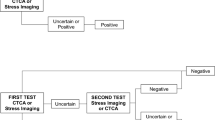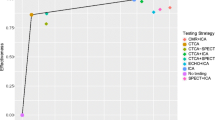Abstract
Objective
To conduct an economic analysis (EA) of coronary calcium scoring (CCS) using a 0 score, as alternative to stress electrocardiography (sECG) in diagnosing coronary artery disease (CAD).
Method
A decision tree was constructed to compare four strategies for investigation of suspected CAD previously assessed in the formulation of clinical guidelines for the United Kingdom (UK) to two new strategies incorporating CCS. Sensitivity (96%; 95% CI 95.4–96.4%) and specificity (40%; 95% CI 38.7–41.4%) values for CCS were derived from a meta-analysis of 10,760 patients. Other input variables were obtained from a previous EA and average prices for hospital procedures in the UK. A threshold of £30,000/Quality-adjusted Life Year (QALY) was considered cost-effective.
Results
Using net monetary benefit calculations, CCS-based strategies were found to be cost-effective compared to sECG equivalents at all assessed prevalence of CAD. Using CCS prior to myocardial perfusion scintigraphy (MPS) and catheter angiography (CA) was found to be cost-effective at pre-test probabilities (PTP) below 30%.
Conclusions
Adoption of CCS as an alternative to sECG in investigating suspected stable angina in low PTP population (<30%) would be cost-effective. In patients with PTP of CAD >30%, proceeding to MPS or CA would be more cost-effective than performing either CCS or sECG.
Key Points
-
Coronary calcium scoring (CCS) is useful for assessing coronary artery atherosclerosis
-
It can be performed with multi-detector CT, which is now widely available
-
It plays a role in excluding disease in suspected stable angina
-
Our study assesses its role in this setting as alternative to stress-ECG
-
Adoption of CCS as an alternative to sECG could prove cost-effective



Similar content being viewed by others
References
O’Rourke RA, Brundage BH, Froelicher VF, Greenland P et al (2000) American College of Cardiology/American Heart Association Expert Consensus document on electron-beam computed tomography for the diagnosis and prognosis of coronary artery disease. Circulation 102:126–140
Budoff MJ, Achenbach S, Blumenthal RS, Carr J et al (2006) Assessment of coronary artery disease by cardiac computed tomography: a scientific statement from the American Heart Association Committee on Cardiovascular Imaging and intervention, Council on Cardiovascular Radiology and Intervention, and Committee on Cardiac Imaging, Council on Clinical Cardiology. Circulation 114:1761–1791
Greenland P, Bonow RO, Brundage BH, Budoff MJ et al (2007) ACCF/AHA2007 clinical expert consensus document on coronary artery calcium scoring by computed tomography in global cardiovascular risk assessment and in evaluation of patients with chest pain: a report of the American College of Cardiology Foundation Clinical Expert Consensus Task Force (ACCF/AHA Writing Committee to Update the 2000 Expert Consensus Document on Electron Beam Computed Tomography). Circulation 115:402–426
Oudkerk M, Stillman AE, Halliburton SS, Kalender WA et al (2008) Coronary artery calcium screening: current status and recommendations from the European Society of Cardiac Radiology and North American Society for Cardiovascular Imaging. Int J Cardiovasc Imag 24:645–671
National Institute for Health and Clinical Excellence (2010) Chest pain of recent onset: assessment and diagnosis of recent onset chest pain or discomfort of suspected cardiac origin. NICE clinical guideline 95. National Institute for Health and Clinical Excellence, London. Available via http://www.nice.org.uk/nicemedia/live/12947/47938/47938.pdf Accessed 3 June 2011
National Institute for Health and Clinical Excellence (2003) Myocardial perfusion scintigraphy for the diagnosis and management of angina and myocardial infarction. Technology Appraisal 73. National Institute for Health and Clinical Excellence, London. Available via http://www.nice.org.uk/nicemedia/live/11520/47940/47940.pdf Accessed 3 June 2011
Mowatt G, Vale L, Brazzelli M, Hernandez R et al (2004) Systematic review of the effectiveness and cost effectiveness, and economic evaluation, of myocardial perfusion scintigraphy for the diagnosis and management of angina and myocardial infarction. Health Tech Assess 8:1–207
Sutton AJ, Cooper NJ, Goodacre S, Stevenson M (2008) Integration of meta-analysis and economic decision modeling for evaluating diagnostic tests. Med Decis Making 28:650
Deeks J (2001) Systematic reviews of evaluations of diagnostic and screening tests. BMJ 323:157–162
Department of Health (2004) NHS reference costs 2003 and National tariff 2004 (payment by results core tools 2004). Appendix 9: Tariff for other service areas. Department of Health, London. Available via http://collections.europarchive.org/tna/20081107212922/http://dh.gov.uk/en/Publicationsandstatistics/Publications/PublicationsPolicyAndGuidance/DH_4070195?IdcService=GET_FILE&dID=26630&Rendition=Web Accessed 3 June 2011
Haberl R, Becker A, Leber A, Knez A et al (2001) Correlation of coronary calcification and angiographically documented stenoses in patients with suspected coronary artery disease: results of 1,764 patients. J Am Coll Cardiol 37(2):451–457
Budoff MJ, Diamond GA, Raggi P, Yadon A et al (2002) Continuous probabilistic prediction of angiographically significant coronary atery disease using electron beam tomography. Circulation 105:1791–1796
Knez A, Becker A, Leber A, White C et al (2004) Relation of coronary calcium scores by electron beam tomography to obstructive disease in 2,115 symptomatic patients. Am J Cardiol 93:1150–1152
Becker A, Leber A, White CW, Becker C et al (2007) Multislice computed tomography for determination of coronary artery disease in a symptomatic patient population. Int J Cardiovasc Imag 23:361–367
National Institute for Health and Clinical Excellence (2007) The guidelines manual. 8: incorporating health economics in guidelines and assessing resource impact. National Institute for Health and Clinical Excellence, London. Available via http://www.nice.org.uk/niceMedia/pdf/GuidelinesManualChapter8.pdf. Accessed 3 June 2011
Budoff MJ (2009) Maximizing dose reductions with cardiac CT. Int J Cardiovasc Imag 25:279–287
Health Protection Agency (2008) Patient dose information. Health Protection Agency, London. Available via http://www.hpa.org.uk/Topics/Radiation/UnderstandingRadiation/UnderstandingRadiationTopics/MedicalRadiation/medic_TedEquivalent/ Accessed 3 June 2011
Coletti PM (2008) Incidental findings on cardiac imaging. AJR 191:882–884
Mowatt G, Cummins E, Waugh N, Walker S, et al. (2008) Systematic review of the clinical effectiveness and cost-effectiveness of 64-slice or higher computed tomography angiography as an alternative to invasive coronary angiography in the investigation of coronary artery disease. Health Technol Assess 12: iii–iv, ix-143
Berman DS, Wong ND, Gransar H, Miranda-Peats R et al (2004) Relationship between stress-induced myocardial ischemia and atherosclerosis measured by coronary calcium tomography. J Am Coll Cardiol 44:923–930
Acknowledgements
Authors performed statistical analysis in this study. In particular we wish to thank Dr A. Parfienczyk and the staff at the Clinical Imaging Sciences Centre, Falmer Campus, Brighton and Sussex Medical School.
Author information
Authors and Affiliations
Corresponding author
Rights and permissions
About this article
Cite this article
Raman, V., McWilliams, E.T.M., Holmberg, S.R.M. et al. Economic analysis of the use of coronary calcium scoring as an alternative to stress ECG in the non-invasive diagnosis of coronary artery disease. Eur Radiol 22, 579–587 (2012). https://doi.org/10.1007/s00330-011-2304-2
Received:
Revised:
Accepted:
Published:
Issue Date:
DOI: https://doi.org/10.1007/s00330-011-2304-2




